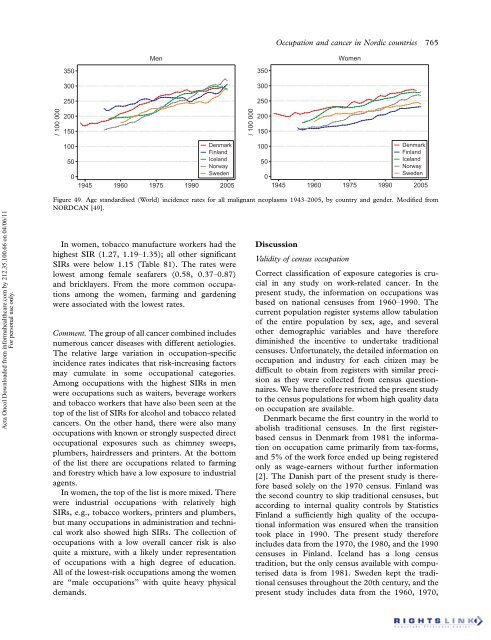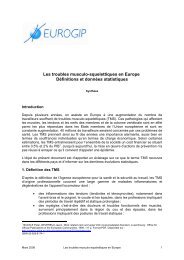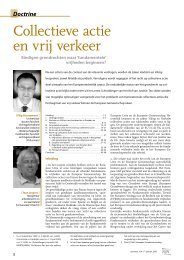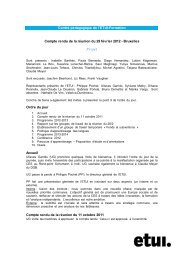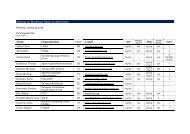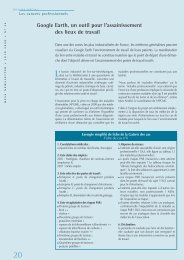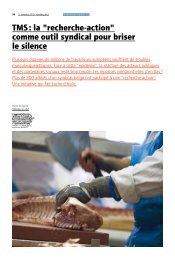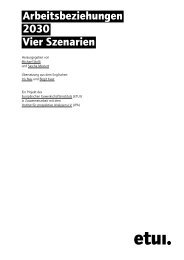Occupation and cancer - European Trade Union Institute (ETUI)
Occupation and cancer - European Trade Union Institute (ETUI)
Occupation and cancer - European Trade Union Institute (ETUI)
Create successful ePaper yourself
Turn your PDF publications into a flip-book with our unique Google optimized e-Paper software.
Acta Oncol Downloaded from informahealthcare.com by 212.35.100.66 on 04/06/11<br />
For personal use only.<br />
/ 100 000<br />
350<br />
300<br />
250<br />
200<br />
150<br />
Men<br />
100<br />
Denmark<br />
Finl<strong>and</strong><br />
50<br />
Icel<strong>and</strong><br />
Norway<br />
0<br />
Sweden<br />
1945 1960 1975 1990 2005<br />
In women, tobacco manufacture workers had the<br />
highest SIR (1.27, 1.19 1.35); all other significant<br />
SIRs were below 1.15 (Table 81). The rates were<br />
lowest among female seafarers (0.58, 0.37 0.87)<br />
<strong>and</strong> bricklayers. From the more common occupations<br />
among the women, farming <strong>and</strong> gardening<br />
were associated with the lowest rates.<br />
Comment. The group of all <strong>cancer</strong> combined includes<br />
numerous <strong>cancer</strong> diseases with different aetiologies.<br />
The relative large variation in occupation-specific<br />
incidence rates indicates that risk-increasing factors<br />
may cumulate in some occupational categories.<br />
Among occupations with the highest SIRs in men<br />
were occupations such as waiters, beverage workers<br />
<strong>and</strong> tobacco workers that have also been seen at the<br />
top of the list of SIRs for alcohol <strong>and</strong> tobacco related<br />
<strong>cancer</strong>s. On the other h<strong>and</strong>, there were also many<br />
occupations with known or strongly suspected direct<br />
occupational exposures such as chimney sweeps,<br />
plumbers, hairdressers <strong>and</strong> printers. At the bottom<br />
of the list there are occupations related to farming<br />
<strong>and</strong> forestry which have a low exposure to industrial<br />
agents.<br />
In women, the top of the list is more mixed. There<br />
were industrial occupations with relatively high<br />
SIRs, e.g., tobacco workers, printers <strong>and</strong> plumbers,<br />
but many occupations in administration <strong>and</strong> technical<br />
work also showed high SIRs. The collection of<br />
occupations with a low overall <strong>cancer</strong> risk is also<br />
quite a mixture, with a likely under representation<br />
of occupations with a high degree of education.<br />
All of the lowest-risk occupations among the women<br />
are ‘‘male occupations’’ with quite heavy physical<br />
dem<strong>and</strong>s.<br />
/ 100 000<br />
350<br />
300<br />
250<br />
200<br />
150<br />
<strong>Occupation</strong> <strong>and</strong> <strong>cancer</strong> in Nordic countries 765<br />
Women<br />
100<br />
Denmark<br />
Finl<strong>and</strong><br />
50<br />
Icel<strong>and</strong><br />
Norway<br />
0<br />
Sweden<br />
1945 1960 1975 1990 2005<br />
Figure 49. Age st<strong>and</strong>ardised (World) incidence rates for all malignant neoplasms 1943 2005, by country <strong>and</strong> gender. Modified from<br />
NORDCAN [49].<br />
Discussion<br />
Validity of census occupation<br />
Correct classification of exposure categories is crucial<br />
in any study on work-related <strong>cancer</strong>. In the<br />
present study, the information on occupations was<br />
based on national censuses from 1960 1990. The<br />
current population register systems allow tabulation<br />
of the entire population by sex, age, <strong>and</strong> several<br />
other demographic variables <strong>and</strong> have therefore<br />
diminished the incentive to undertake traditional<br />
censuses. Unfortunately, the detailed information on<br />
occupation <strong>and</strong> industry for each citizen may be<br />
difficult to obtain from registers with similar precision<br />
as they were collected from census questionnaires.<br />
We have therefore restricted the present study<br />
to the census populations for whom high quality data<br />
on occupation are available.<br />
Denmark became the first country in the world to<br />
abolish traditional censuses. In the first registerbased<br />
census in Denmark from 1981 the information<br />
on occupation came primarily from tax-forms,<br />
<strong>and</strong> 5% of the work force ended up being registered<br />
only as wage-earners without further information<br />
[2]. The Danish part of the present study is therefore<br />
based solely on the 1970 census. Finl<strong>and</strong> was<br />
the second country to skip traditional censuses, but<br />
according to internal quality controls by Statistics<br />
Finl<strong>and</strong> a sufficiently high quality of the occupational<br />
information was ensured when the transition<br />
took place in 1990. The present study therefore<br />
includes data from the 1970, the 1980, <strong>and</strong> the 1990<br />
censuses in Finl<strong>and</strong>. Icel<strong>and</strong> has a long census<br />
tradition, but the only census available with computerised<br />
data is from 1981. Sweden kept the traditional<br />
censuses throughout the 20th century, <strong>and</strong> the<br />
present study includes data from the 1960, 1970,


